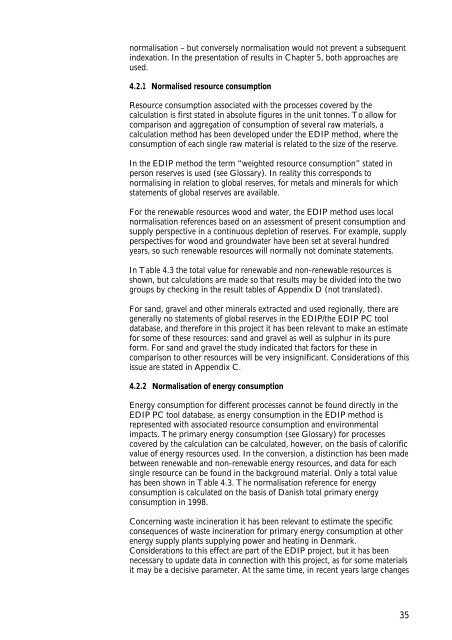Waste Indicators
Waste Indicators
Waste Indicators
You also want an ePaper? Increase the reach of your titles
YUMPU automatically turns print PDFs into web optimized ePapers that Google loves.
normalisation – but conversely normalisation would not prevent a subsequentindexation. In the presentation of results in Chapter 5, both approaches areused.4.2.1 Normalised resource consumptionResource consumption associated with the processes covered by thecalculation is first stated in absolute figures in the unit tonnes. To allow forcomparison and aggregation of consumption of several raw materials, acalculation method has been developed under the EDIP method, where theconsumption of each single raw material is related to the size of the reserve.In the EDIP method the term “weighted resource consumption” stated inperson reserves is used (see Glossary). In reality this corresponds tonormalising in relation to global reserves, for metals and minerals for whichstatements of global reserves are available.For the renewable resources wood and water, the EDIP method uses localnormalisation references based on an assessment of present consumption andsupply perspective in a continuous depletion of reserves. For example, supplyperspectives for wood and groundwater have been set at several hundredyears, so such renewable resources will normally not dominate statements.In Table 4.3 the total value for renewable and non-renewable resources isshown, but calculations are made so that results may be divided into the twogroups by checking in the result tables of Appendix D (not translated).For sand, gravel and other minerals extracted and used regionally, there aregenerally no statements of global reserves in the EDIP/the EDIP PC tooldatabase, and therefore in this project it has been relevant to make an estimatefor some of these resources: sand and gravel as well as sulphur in its pureform. For sand and gravel the study indicated that factors for these incomparison to other resources will be very insignificant. Considerations of thisissue are stated in Appendix C.4.2.2 Normalisation of energy consumptionEnergy consumption for different processes cannot be found directly in theEDIP PC tool database, as energy consumption in the EDIP method isrepresented with associated resource consumption and environmentalimpacts. The primary energy consumption (see Glossary) for processescovered by the calculation can be calculated, however, on the basis of calorificvalue of energy resources used. In the conversion, a distinction has been madebetween renewable and non-renewable energy resources, and data for eachsingle resource can be found in the background material. Only a total valuehas been shown in Table 4.3. The normalisation reference for energyconsumption is calculated on the basis of Danish total primary energyconsumption in 1998.Concerning waste incineration it has been relevant to estimate the specificconsequences of waste incineration for primary energy consumption at otherenergy supply plants supplying power and heating in Denmark.Considerations to this effect are part of the EDIP project, but it has beennecessary to update data in connection with this project, as for some materialsit may be a decisive parameter. At the same time, in recent years large changes35
















